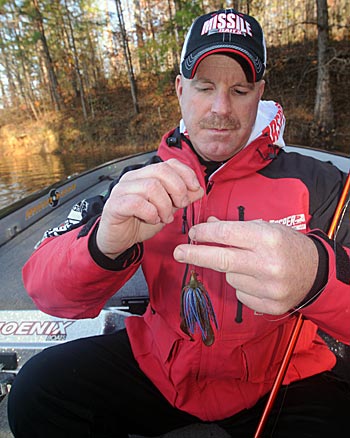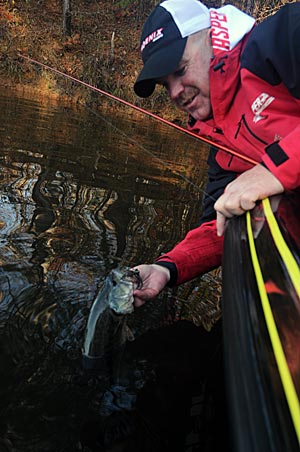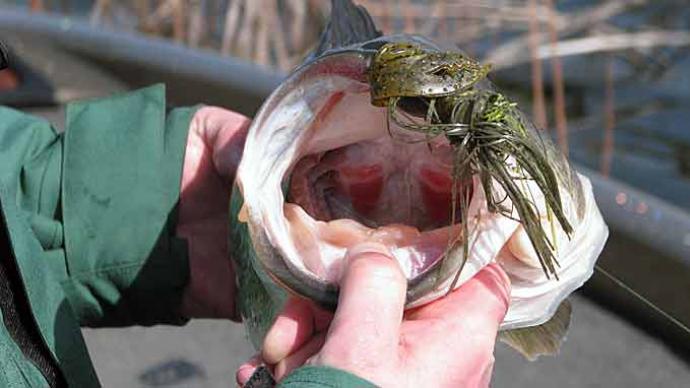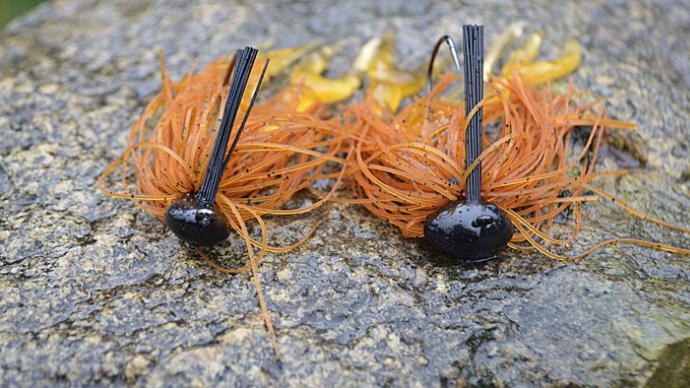
When winter arrives, and the water turns cold, Chad Morgenthaler relies on a jig because he knows it produces in just about any situation.
“A jig can be effective in any condition in the wintertime for me,” Morgenthaler says. “I just change the area that I target with it.” Morgenthaler will throw a jig in open water along hard bottom spots of channel swings, ledges, and long tapering points if the weather is cloudy and windy. On sunny, windy days, Morgenthaler targets cover such as docks and laydowns along creek channels where bass move into shallower, warmer water. On sunny, calm days, he throws his jig at deeper cover, such as brush piles, standing cedar trees, stumps, and rock piles.
The Bassmaster Elite Series pro believes a jig is ideal for winter bass because the lure can be dragged slowly to imitate crayfish, which are prevalent along rocky bottoms throughout the winter.
Both big and small jigs produce wintertime bass for Morgenthaler. His favorite wintertime jigs include a 3/4-ounce Strike King Tour Grade Football Jig and 1/2-ounce Strike King Tour Grade Finesse Football Jig for dragging in deeper water, and 1/2-ounce Missile Baits Headbanger Jig and 1/2-ounce Missile Baits Ike’s Mini Flip Jig for fishing shallower cover.
For most situations, the Missouri pro matches his jigs with various soft plastic trailers such as the Strike King Rage Craw and Missile Baits Craw Father. He opts for a Missile Baits Twin Turbo double tail grub when he wants to swim the jig or have it fall slowly when bass are suspended in standing timber. When he wants to downsize the profile of his jig and trailer or give it a baitfish look, Morgenthaler matches the jig with a Missile Baits Baby D Bomb.
Morgenthaler keeps his color choices simple for his wintertime jigs. He favors jigs in green pumpkin with light blue strands, watermelon red flake, green pumpkin candy, and brown/orange hues. The touring pro will match or contrast the colors of his trailer and jig.

The six-time Bassmaster Classic qualifier improves his jig’s hook-setting potential by modifying the lure’s weed guard. He mashes the weed guard down to the hook and cuts the guard’s strands, so the weed guard only covers the back of the hook barb.
Morgenthaler employs a couple of retrieves for his wintertime jig tactics, depending on whether he is searching for bass or has pinpointed fish. “I will do a slow swim with it when searching for bass, which is just a continuous retrieve, but it is a much slower turn of the reel handle just like I would with a wobble head jig,” says Morgenthaler, who switches retrieves after he gets a bite. “I will use a slow drag similar to a Carolina rig and alter those drag distances. I may drag it 6 inches, or I may drag it t 2 to 4 feet before I stop it depending on the conditions.” He also likes to drag his jig because the lure allows him to feel hard spots like big rocks along the bottom.
The versatility of a jig allows Morgenthaler to fish the lure at various depths throughout the winter. “I have caught bass on those sunny, windy days less than 8 feet deep, and on other days I have caught them to 40 feet deep,” Morgenthaler says. He retrieves his jigs with a 7-foot medium-heavy Team Lew’s Custom Pro Speed Stick rod and Team Lew’s Pro Ti 7.5:1 gear ratio baitcast reel filled with 12- or 16-pound Gamma Edge Fluorocarbon line.
Jigs produce both numbers and big bass for Morgenthaler throughout the winter. “I have had some phenomenal days when I have caught 20 or 25 fish and have 18- to 22-pound (five fish) stringers,” Morgenthaler says. “A jig always has the possibility of producing that giant fish.”
The jig pattern changes for Morgenthaler throughout the various stages of winter. “As the winter progresses, I find in the dead of winter is when I catch my larger fish, and they will stay more consistent,” he says. “Once I figure out that depth range and the retrieve, those fish will stay for a while as long as there is not a major weather swing one way or the other. And the deeper they are, the longer, the larger fish will stay there.” With the lack of fishing pressure in the wintertime, Morgenthaler knows he can keep catching those schools of big bass until a significant weather front or an increase in current affects those fish.
Longer periods of daylight in late winter will also start changing Morgenthaler’s jig pattern. “As the water starts to warm and the weather progresses towards springtime, you will notice the change with the size of the fish and depth range.” Then Morgenthaler notices male bass will start moving into the 6-to-12-foot depth range and get active while prespawn females will move around to different staging areas.
BassResource may receive a portion of revenues if you make a purchase using a link above.



